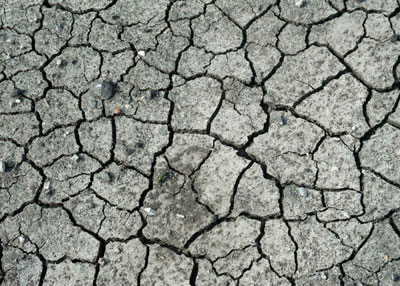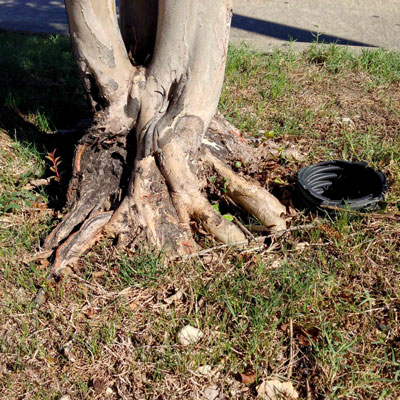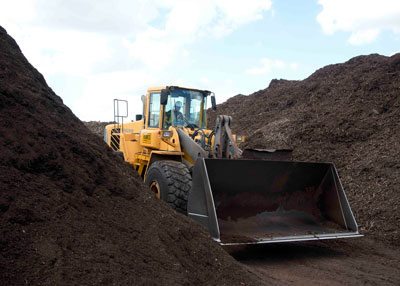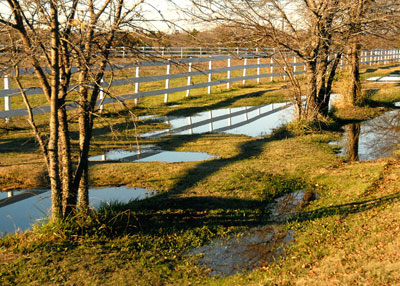Soils Made Interesting
I took my basic Soils Science class at Texas A&M a year before I transferred to Ohio State. I enjoyed it because I had a good prof, and I learned a good bit.
But that was a full semester’s course, and I’m not going to write that much here. So I’ll try to boil it down to the short-form edition. These are things you need to know about the soil in which you garden. I hope you find them interesting.

Houston black clay loam runs all along the I-35 corridor. Only a foot or two down, crews here near the McKinney airport have run into white caliche bedrock.
• Particle size. Starting with the largest particle sizes, soils can be sand, silt or clay. If you want to see them more clearly, put a cupful of soil in a clear quart Mason jar. Fill the jar almost completely with water, and shake it vigorously for a couple of minutes – until all of the soil is in suspension (no clods or clumps). Carefully set it down on a bright windowsill and watch it periodically for a day or two. Gravel and sand will settle out first. Silt will come next (similar to what accumulates on the edge of a lake), and clay will remain in suspension the longest (perhaps days).

Silt accumulates along shore of lakes as water recedes.
• Depth. This will be critical in determining which plants will grow well for you. Some need much deeper soils than others. Shumard red oaks, for example, will grow in shallow, gravelly soil, while pecans need several feet of soil to have a good chance at success. Depth also determines drainage, most especially when you are creating a raised bed. Even a few inches of elevation will let excess water drain away quickly.

Adding fill soil over a tree’s roots is usually a bad plan, but this crape myrtle definitely has suffered a couple of inches of soil erosion.
• Acidity or alkalinity (pH). This is a measure on a scale of 1 (extreme acidity) to 14 (extreme alkalinity). 7.0 is a neutral pH. Almost all cultivated plants will grow better in soils that are slightly below neutral – slightly acidic. The plants that need copious amounts of iron will face extreme challenges in alkaline soils. Iron deficiency will ensue, with characteristic symptoms being yellowed leaves with dark green veins, most prominent on the newest growth first. You deal with alkaline soils by adding sulfur soil acidifier and/or by adding organic matter. However, that’s only practical for relatively small plants like azaleas and gardenias, certainly not for large shade trees. You can also add iron amendments, but only if they’re done in tandem with the soil acidifier.
• Color. Most people don’t think about color as being of much importance. However, dark soils (brown or black) indicate high levels of organic matter. Orange and red soils are almost always acidic. Those pigments come from the presence of soluble iron. White soils are, like beach sand, very porous and quite infertile. Yellow soils suggest poor drainage and are often accompanied by the smell of stagnant, soured ground. You can tell a lot about a soil by its color.
• Fertility. You’ll need a soil test to determine this. However, as mentioned, dark soils are often more fertile, and light-colored soils are generally in need to nutrients. Most clay soils in Texas already have excessive amounts of phosphorus, the middle number of the fertilizer analysis. You can have your soil tested at the Texas A&M Soil Testing Laboratory. http://soiltesting.tamu.edu for a modest fee.
• Organic matter content. There is a neat little fact here: you can add organic matter (peat moss, compost, rotted manure, finely shredded pine bark mulch, etc.) to any type of soil (sand or clay) to improve it. Organic matter opens up tight clays, and it helps sandy soils hold moisture and nutrients. In this one case, one product does all.

Front-end loader is being used to blend composted organic matter in background into a planting mix.
• Water table/drainage. Oh, my, how we discovered the importance of this last year. The “water table” refers to where the water seepage would be if you carefully dug a hole and left it open. After heavy rains, you would expect the hole to fill partially or completely with water. The higher the water table is in the soil, the more critical it is that you garden in raised beds.

Several days after rain, water is still standing alongside this Collin County road. The soil’s water table must be quite near the soil’s surface.
